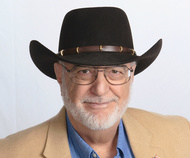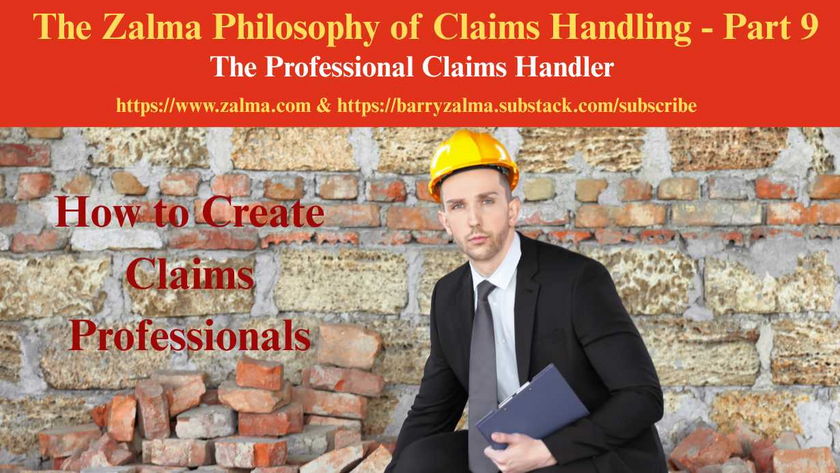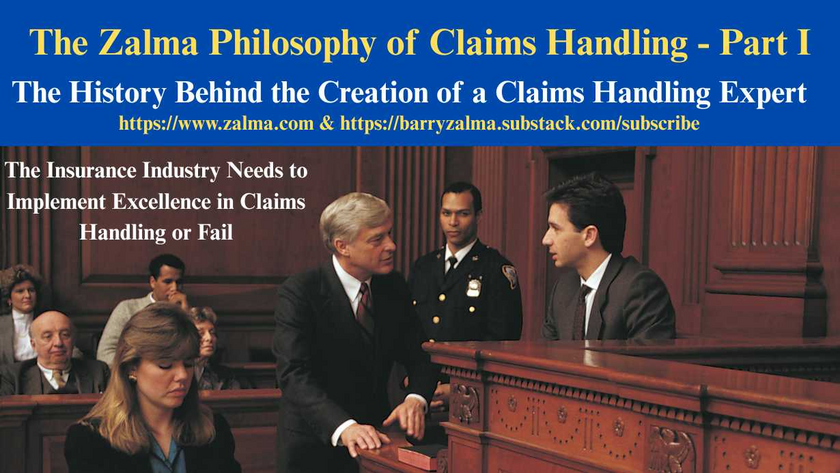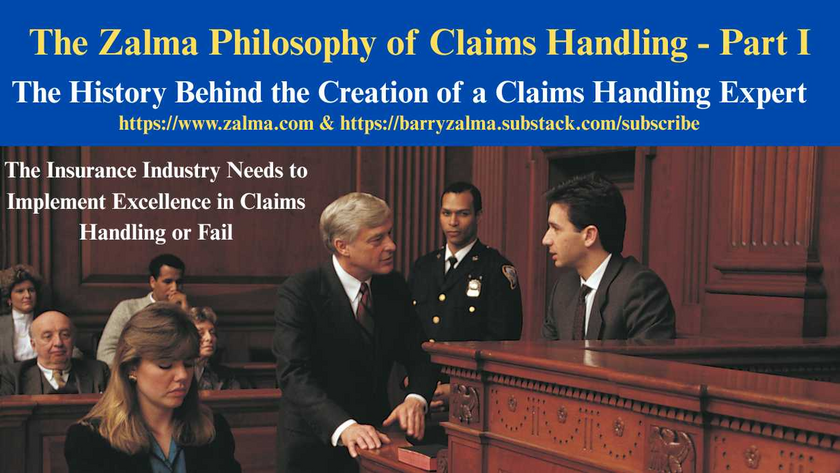
Waiver of Subrogation Defeats Claims Against Contractor Who Caused Fire
Read the full article at https://www.linkedin.com/pulse/contract-made-action-even-signed-after-termination-zalma-esq-cfe and at https://zalma.com/blog plus more than 4150 posts.
Posted on March 31, 2022 by Barry Zalma
Commercial General Liability and Commercial Property Policies allow an insured to waive the insurer’s right of subrogation if made before a loss. In The State Of Delaware Insurance Coverage Office, and Factory Mutual Insurance Co., both as subrogee of the University of Delaware v. Disabatino Construction Co., Schlosser & Associates Mechanical Contractors, Inc., And V.E. Guerrazzi, Inc., C. A. No. N19C-08-080 EMD CCLD, Superior Court of Delaware (March 17, 2022) the court resolved motions for summary judgment regarding a waiver of subrogation.
INTRODUCTION
A breach of contract and negligence action where the State of Delaware Insurance Coverage Office and Factory Mutual Insurance Company (collectively, “Plaintiffs”) sued as subrogees of the University of Delaware (the “University”). Plaintiffs trued recover what they paid relating to a fire allegedly caused by Defendants DiSabatino Construction Company (“DiSabatino”), Schlosser & Associates Mechanical Contractors (“Schlosser”), and V.E. Guerrazi, Inc. (“Guerrazi,” and collectively, “Defendants”), who were working for the University as contractors.
BACKGROUND
Plaintiffs paid the University of Delaware $2.5 million and $2.75 million, respectively, for damages related to the fire at McKinly Hall. Plaintiffs are subrogated to the University’s rights to the extent of these payments.
The defendants provided contracting services for the University in 2017. DiSabatino was the general contractor on the project to renovate Lab 46 in McKinly Hall (the “Project”), Schlosser was the subcontractor, and Guerrazzi was the sub-subcontractor.
The University created a 424-page specifications manual (the “Specifications”) as a “road map” of the Project for potential bidders. The Specifications charged bidders to “[u]se A101 2007 and A201 2007 with the following supplemental information.” A101 2007 and A2 2007 refer to form construction contracts published by the American Institute of Architects. The AIA Contract includes a waiver of subrogation.
The University needed the Project to be completed before students returned in Fall 2017. The University authorized DiSabatino to begin work immediately after it received the construction permit.
DiSabatino had almost completed the Project when a fire occurred in McKinly Hall. After the fire, DiSabatino realized it had not received an executed contract from the University. The University suggested that the retroactive AIA Contract should have a contract commencement date of May 31, 2017. DiSabatino did not object. The University agreed that the original AIA Contract terms, as included by the University in the Specifications, would remain in place. The University never provided DiSabatino with an executed copy of the AIA Contract. DiSabatino did not ask the University to execute the AIA Contract because it “believed [they] were under contract,” such that the “actual signature” seemed “superfluous.”
Section 11.3.7 of the A201, titled “Waivers of Subrogation,” reads as follows:
The Owner and Contractor waive all rights against (1) each other and any of their subcontractors, sub-subcontractors, agents and employees, each of the other, and (2) the Architect, Architect’s consultants, separate contractors described in Article 6, if any, and any of their subcontractors, sub-subcontractors, agents and employees, for damages caused by fire or other causes of loss to the extent covered by property insurance obtained pursuant to this Section … The policies shall provide such waivers of subrogation by endorsement or otherwise. A waiver of subrogation shall be effective as to a person or entity even though that person or entity would otherwise have a duty of indemnification, contractual or otherwise, did not pay the insurance premium directly or indirectly, and whether or not the person or entity had an insurable interest in the property damaged.
Plaintiffs sued seeking-through subrogation-to recover damages to the University resulting from the fire.
Defendants moved to dismiss, arguing that the AIA Contract expressly waived subrogation claims. Following discovery, Defendants moved for summary judgment. Defendants argued that the AIA Contract is the operative agreement between the University and DiSabatino, and that because the AIA Contract included a waiver of subrogation, all Plaintiffs’ claims are barred
DISCUSSION
The Court held that the AIA Contract is the operative contract between DiSabatino and the University; that the COSA did not modify the waiver of subrogation in the A201; and that the waiver bars all of Plaintiffs’ claims against all Defendants. It concluded that basic contract law concludes that a valid contract exists when
the parties intended that the contract would bind them,
the terms of the contract are sufficiently definite, and
the parties exchanged legal consideration
The Court found that the University and DiSabatino objectively manifested assent to using the AIA Contract as their contract. In the Specifications, a section titled “Contract” directed bidders to “use A101 2007 and A201 2007 with the following supplemental information.” In other words, the University expressly informed DiSabatino during bidding that the contract would be the AIA Contract. DiSabatino agreed. By signing the Bid Form included in the Specifications, DiSabatino certified that it understood the requirements detailed in the Specifications and that it would carry out the Project “in accordance with the Specifications . . . .” Therefore, the University and DiSabatino objectively manifested assent to using the AIA Contract during the bidding stage of their relationship.
Although the University and DiSabatino did not execute the AIA Contract as the Specifications required, the Court found that their conduct after the University selected DiSabatino’s bid manifests an intent to be bound by the AIA Contract. The conduct of the parties after the fire provides the final proof of their intent. DiSabatino sent the University additional copies of the short-form contract and Supplement. The University, by its actions, clearly regarded the AIA Contract as the operative contract between itself and DiSabatino. Otherwise, the University would have had no reason to ask DiSabatino to sign and submit it. DiSabatino did, as requested submit the signed AIA Contract, thereby confirming its assent to being bound by its terms.
The Waiver of Subrogation Extends to all Damages
The fire in McKinly Hall damaged both the areas that Defendants were renovating for the Project and other areas, which were not part of the Project. Plaintiffs argued the waiver of subrogation should apply only to damages associated with the Project, and not to the non-Project areas.
The waiver in the A201 expressly states that the “Owner and Contractor waive all rights against (1) each other and any of their subcontractors, sub-subcontractors, agents and employees, each of the other . . . for damages caused by fire or other causes of loss . . . .” This language unambiguously means that the waiver extends to Schlosser and Guerrazzi. The Court finds that an argument to the contrary is an unreasonable interpretation of the unambiguous language of the operative document.
Defendants’ motions for summary judgment were granted.
ZALMA OPINION
Waivers of subrogation are important to the construction industry and act as a means to transfer the risks of loss of a negligently caused fire from the contractors to an insurer. The waiver saves money on the contract terms and makes it possible for an owner to quickly recover from losses by fire from their insurers and allows a contractor to protect its assets by insurance taken out by the owner who, with the permission of its insurer, waives the insurer’s right to subrogation. The only reason this case went to summary judgment was the fact that the parties acted loosely with regard to signing the contract. The actions of the parties established the intent to be bound by the AIA contract and its waiver of subrogation and the insurers, therefore, cannot recover from who it believed to be the party responsible for the fire.
(c) 2022 Barry Zalma & ClaimSchool, Inc.
Barry Zalma, Esq., CFE, now limits his practice to service as an insurance consultant specializing in insurance coverage, insurance claims handling, insurance bad faith and insurance fraud almost equally for insurers and policyholders. He practiced law in California for more than 44 years as an insurance coverage and claims handling lawyer and more than 54 years in the insurance business. He is available at http://www.zalma.com and [email protected].
Subscribe to Zalma on Insurance at locals.com https://zalmaoninsurance.local.com/subscribe.
Subscribe to Excellence in Claims Handling at https://barryzalma.substack.com/welcome.
Write to Mr. Zalma at [email protected]; http://www.zalma.com; http://zalma.com/blog; daily articles are published at https://zalma.substack.com. Go to the podcast Zalma On Insurance at https://anchor.fm/barry-zalma; Follow Mr. Zalma on Twitter at https://twitter.com/bzalma; Go to Barry Zalma videos at Rumble.com at https://rumble.com/c/c-262921; Go to Barry Zalma on YouTube- https://www.youtube.com/channel/UCysiZklEtxZsSF9DfC0Expg; Go to the Insurance Claims Library – https://zalma.com/blog/insurance-claims-library/
Refusal to Provide Workers’ Compensation is Expensive
Post 5240
Read the full article at https://lnkd.in/guC9dnqA, see the video at https://lnkd.in/gVxz-qmk and at https://lnkd.in/gUTAnCZw, and at https://zalma.com/blog plus more than 5200 posts.
In Illinois Department of Insurance, Insurance Compliance Department v.USA Water And Fire Restoration, Inc., And Nicholas Pacella, Individually And As Officer, Nos. 23WC021808, 18INC00228, No. 25IWCC0467, the Illinois Department of Insurance (Petitioner) initiated an investigation after the Injured Workers’ Benefit Fund (IWBF) was added to a pending workers’ compensation claim. The claim alleged a work-related injury during employment with the Respondents who failed to maintain workers’ compensation Insurance.
Company Overview:
USA Water & Fire Restoration, Inc. was incorporated on January 17, 2014, and dissolved on June 14, 2019, for failure to file annual reports and pay franchise taxes. It then operated under assumed names including USA Board Up & Glass Co. and USA Plumbing and Sewer. The business ...
Arsonist Incompetently Moves Pro Se to Avoid Prison
Post 5239
Read the full article at https://lnkd.in/gRX8TfKn, see the video at https://lnkd.in/gY3Jvnqp and at https://lnkd.in/gRCaaf-3, and at https://zalma.com/blog plus more than 5200 posts.
In Christopher A. Barosh v. Morris Houser, et al., Civ. No. 22-0769, United States District Court, E.D. Pennsylvania (November 25, 2025) a convicted arsonist and insurance fraudster moved the USDC acting in Pro se filed Objections to Magistrate Judge Reid’s Recommendation that the US District Judge dismiss his § 2254 Petition to avoid jail.
BACKGROUND
In October 2005, Barosh set fire to his girlfriend’s Philadelphia home — some 25 hours before the cancellation of the property’s insurance policy. Several witnesses saw Barosh leaving the property shortly before the fire erupted. After the fire, Barosh made “two separate admissions of guilt.”
He attempted to pay an acquaintance to provide him with an alibi for the time of the arson. The eyewitnesses, brother, and ...
Conditional Release Allows Supplemental Claims
Post 5238
Read the full article at https://lnkd.in/ge2yNQby, see the video at https://lnkd.in/gcSF9KWj and at https://lnkd.in/gQfJqwiM, and at https://zalma.com/blog plus more than 5200 posts.
A Release Should Totally Resolve Dispute
In Harvey et al. v. Hall, No. A25A1774, Court of Appeals of Georgia, Fourth Division (December 3, 2025) Paul Harvey, an employee of Arthur J. Dovers (d/b/a 3D Mobile Home Services), drove a truck towing a trailer loaded with machinery and equipment. Harvey fell asleep, veered off the road, and crashed into a culvert, causing Lamar Hall serious injuries.
FACTS OF SETTLEMENT
On August 18, 2020, Hall signed a limited liability release under OCGA § 33-24-41.1, releasing Harvey, Dovers, and their insurer (Georgia Farm Bureau Insurance Company) from liability for the accident in exchange for $50,000, “except to the extent other insurance coverage is available which covers the claim.”
Dovers’s general liability insurer (Republic-Vanguard ...
The Professional Claims Handler
Post 5219
Posted on October 31, 2025 by Barry Zalma
An Insurance claims professionals should be a person who:
Can read and understand the insurance policies issued by the insurer.
Understands the promises made by the policy.
Understand their obligation, as an insurer’s claims staff, to fulfill the promises made.
Are competent investigators.
Have empathy and recognize the difference between empathy and sympathy.
Understand medicine relating to traumatic injuries and are sufficiently versed in tort law to deal with lawyers as equals.
Understand how to repair damage to real and personal property and the value of the repairs or the property.
Understand how to negotiate a fair and reasonable settlement with the insured that is fair and reasonable to both the insured and the insurer.
How to Create Claims Professionals
To avoid fraudulent claims, claims of breach of contract, bad faith, punitive damages, unresolved losses, and to make a profit, insurers ...

The History Behind the Creation of a Claims Handling Expert
The Insurance Industry Needs to Implement Excellence in Claims Handling or Fail
Post 5210
This is a change from my normal blog postings. It is my attempt. in more than one post, to explain the need for professional claims representatives who comply with the basic custom and practice of the insurance industry. This statement of my philosophy on claims handling starts with my history as a claims adjuster, insurance defense and coverage lawyer and insurance claims handling expert.
My Training to be an Insurance Claims Adjuster
When I was discharged from the US Army in 1967 I was hired as an insurance adjuster trainee by a professional and well respected insurance company. The insurer took a chance on me because I had been an Army Intelligence Investigator for my three years in the military and could use that training and experience to be a basis to become a professional insurance adjuster.
I was initially sat at a desk reading a text-book on insurance ...

The History Behind the Creation of a Claims Handling Expert
The Insurance Industry Needs to Implement Excellence in Claims Handling or Fail
Post 5210
This is a change from my normal blog postings. It is my attempt. in more than one post, to explain the need for professional claims representatives who comply with the basic custom and practice of the insurance industry. This statement of my philosophy on claims handling starts with my history as a claims adjuster, insurance defense and coverage lawyer and insurance claims handling expert.
My Training to be an Insurance Claims Adjuster
When I was discharged from the US Army in 1967 I was hired as an insurance adjuster trainee by a professional and well respected insurance company. The insurer took a chance on me because I had been an Army Intelligence Investigator for my three years in the military and could use that training and experience to be a basis to become a professional insurance adjuster.
I was initially sat at a desk reading a text-book on insurance ...














